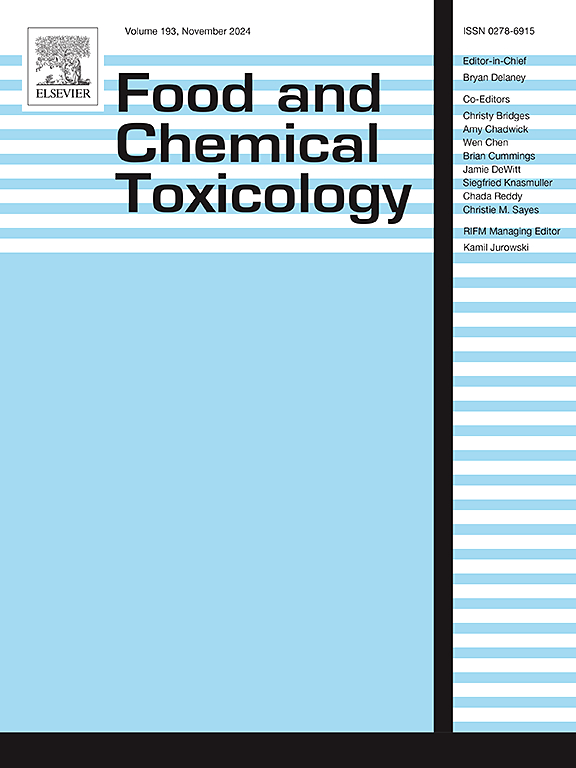Nephroprotective potential of robinin to counteract aldicarb induced renal dysfunction via modulating TLR4/MyD88, HMGB1/RAGE, NF-κB pathway: A biochemical and pharmacodynamic approach
IF 3.9
3区 医学
Q2 FOOD SCIENCE & TECHNOLOGY
引用次数: 0
Abstract
The current investigation was conducted to evaluate the nephroprotective potential of robinin (RBN) to avert aldicarb (ALD) induced renal impairments. Thirty-two adult albino rats (Sprague Dawley) were divided into four groups including control, ALD (15 mgkg-1), ALD (15 mgkg-1) + RBN (6 mgkg-1) and RBN (6 mgkg-1) alone treated group. The results of the current study demonstrated that ALD intoxication increased the gene expression of receptor for advanced glycation end products (RAGE), tumor necrosis factor- α (TNF-α), toll-like receptor 4 (TLR4), high mobility group box1 (HMGB1), nuclear factor-kappa B (NF-κB), myeloid differentiation primary response protein 88 (MyD88), monocyte chemoattractant protein-1 (MCP-1), interleukin-6 (IL-6), cyclooxygenase-2 (COX-2), and interleukin-1β (IL-1β). Moreover, activities of HO-1, GSH, GPx, SOD, GSR, and CAT were suppressed while the levels of ROS and MDA were escalated following the ALD exposure. ALD intoxication upregulated the levels of cystatin C, KIM-1, creatinine, NAG, uric acid, urea, NGAL and BUN while reducing the levels of creatinine clearance in renal tissues. The levels of Bax, Caspase-9 and Caspase-3 were elevated while the levels of Bcl-2 were reduced after ALD administration. Histopathological analysis showed ALD disrupted the normal architecture of renal tissues. However, RBN therapy substantially protected the renal tissues owing to its antioxidative, anti-inflammatory and anti-apoptotic potential.

罗宾素通过调节 TLR4/MyD88、HMGBI/RAGE、NF-κB 途径对抗涕灭威诱导的肾功能障碍的肾保护潜力:生化和药效学方法。
本文章由计算机程序翻译,如有差异,请以英文原文为准。
求助全文
约1分钟内获得全文
求助全文
来源期刊

Food and Chemical Toxicology
工程技术-毒理学
CiteScore
10.90
自引率
4.70%
发文量
651
审稿时长
31 days
期刊介绍:
Food and Chemical Toxicology (FCT), an internationally renowned journal, that publishes original research articles and reviews on toxic effects, in animals and humans, of natural or synthetic chemicals occurring in the human environment with particular emphasis on food, drugs, and chemicals, including agricultural and industrial safety, and consumer product safety. Areas such as safety evaluation of novel foods and ingredients, biotechnologically-derived products, and nanomaterials are included in the scope of the journal. FCT also encourages submission of papers on inter-relationships between nutrition and toxicology and on in vitro techniques, particularly those fostering the 3 Rs.
The principal aim of the journal is to publish high impact, scholarly work and to serve as a multidisciplinary forum for research in toxicology. Papers submitted will be judged on the basis of scientific originality and contribution to the field, quality and subject matter. Studies should address at least one of the following:
-Adverse physiological/biochemical, or pathological changes induced by specific defined substances
-New techniques for assessing potential toxicity, including molecular biology
-Mechanisms underlying toxic phenomena
-Toxicological examinations of specific chemicals or consumer products, both those showing adverse effects and those demonstrating safety, that meet current standards of scientific acceptability.
Authors must clearly and briefly identify what novel toxic effect (s) or toxic mechanism (s) of the chemical are being reported and what their significance is in the abstract. Furthermore, sufficient doses should be included in order to provide information on NOAEL/LOAEL values.
 求助内容:
求助内容: 应助结果提醒方式:
应助结果提醒方式:


